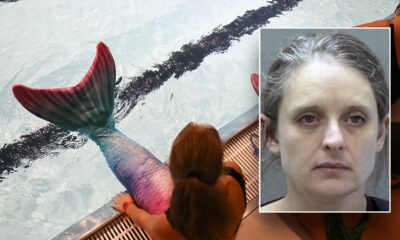Lifestyle
What is a 'flexologist' — and do you need to see one?
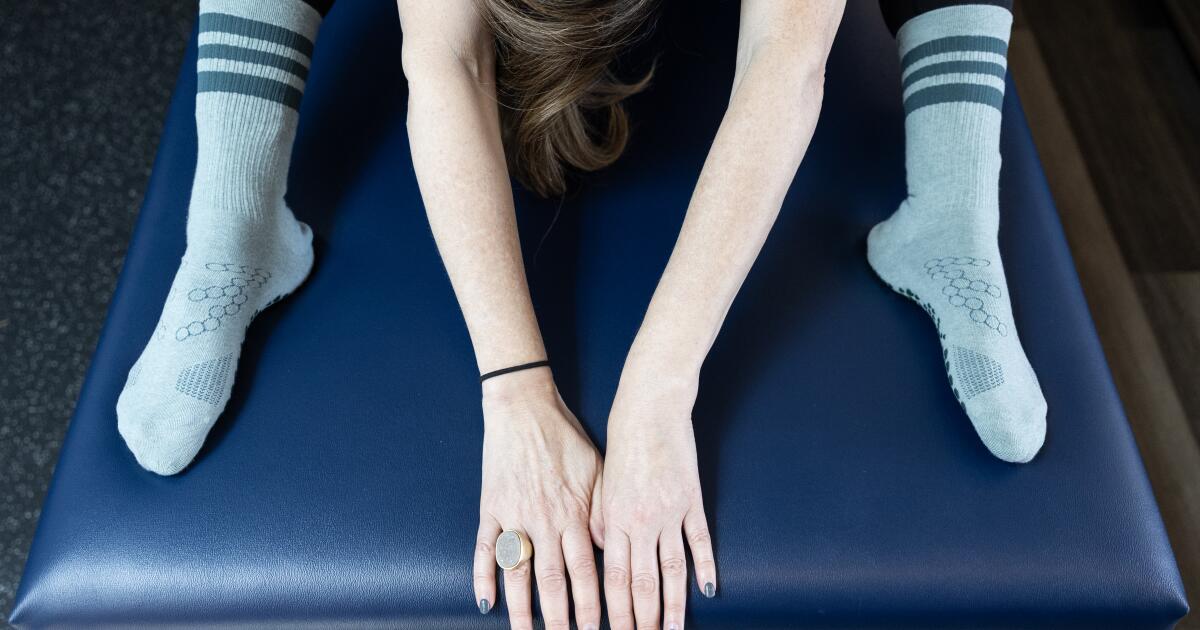
The signs seemed to be proliferating around Los Angeles — along Sunset Boulevard in Echo Park, in mini-malls on Pacific Coast Highway, on side streets in Glendale and Venice: StretchLab, Stretch Zone, StretchSPOT, StretchMed.
Deborah Vankin’s 50-minute stretch session included 13 stretches on either side of her body.
(Luke Johnson / Los Angeles Times)
I’d been curious about assisted stretching for a while. But I never thought to visit a studio. Sure, “recovery” is a growing trend in fitness — meaning rejuvenating muscles, tendons and the central nervous system between exercise sessions by focusing on hydration, proper nutrition, sleep and, yes, active stretching so as to maximize athletic performance. But I own three foam rollers — one smooth, one spiky, one padded — and even use them at home. I’m also far from an extreme athlete, preferring instead brisk hikes for cardio and basic strength training.
Why would I drive to a mini-mall and pay someone to stretch me? What would that even look like — and was it worth it?
The questions rumbled in my head as I drove past yet another StretchLab recently — this one on Beverly Boulevard near Hollywood. So I called them up.
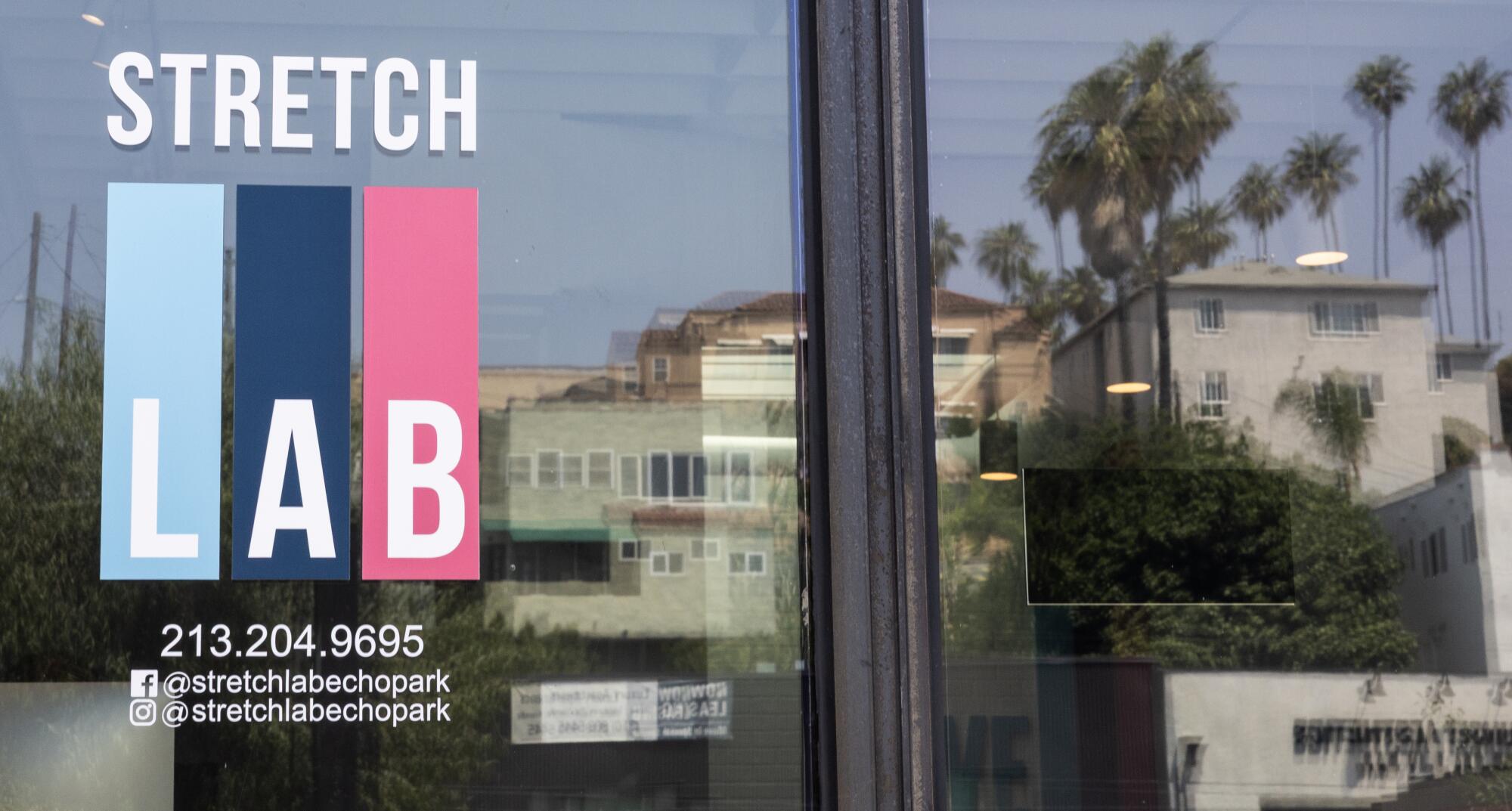
StretchLab has 15 locations in the L.A. area, including in Echo Park.
(Luke Johnson / Los Angeles Times)
Turns out StretchLab, which opened its first studio in Venice in 2015, now has more than 500 studios nationwide, 15 of them in the L.A. area. Its clientele are generally either serious athletes, older adults and desk workers who struggle with stiffness and want to work on their mobility, or those healing injuries and other conditions. They come to be stretched out more deeply, in positions they couldn’t possibly get into, physically, on their own. Many of them appreciate the intimacy and accountability of working with a practitioner, one-on-one. And it can be helpful to have a professional, with a trained eye, isolate asymmetries in their bodies and guide their stretching, especially for those who suffer from chronic pain or are healing an injury, says StretchLab‘s director of marketing, Gabi Khowploum.
“We see a lot of people who say, ‘Hey, I’m having back pain,’” Khowploum says. “And they come to stretch it, but it might be they’re having issues with hip mobility — they just don’t realize it.”
Stretch therapists — or “flexologists,” as they’re sometimes called — are not doctors. Chiropractors, physical therapists and some massage therapists are trained in assisted stretching — but stretch therapists can’t do what they do. Stretch therapists don’t diagnose and treat injuries; they don’t provide spinal or joint manipulation, imaging such as X-rays or CT scans or massage. They focus, instead, on stretching muscles and fascia to increase flexibility and mobility. There also isn’t a national certification for stretch therapists, as there is for physical therapists and chiropractors, though most stretch therapists are certified in-house by their respective employers.
Dr. Jeremy Swisher, a sports medicine physician at UCLA Health, says assisted stretching can help increase range of motion and flexibility, stimulate blood flow, which aids healing, and help with posture, particularly for sedentary populations, as well as alleviate stress. Done consistently, long term, it can help with pain relief and stiffness and — possibly — prevent injuries. But it’s “not a cure-all,” he warns.
“It’s just a piece of the puzzle,” he says. “Strength training and other forms of exercise are equally as important, long term.” Swisher also warns that assisted stretching could exacerbate existing injuries “like an acute sprain or tear without being cleared by a doctor first.” And for those with hypermobility syndromes, meaning overly flexible joints, “it’s important to be mindful that increased stretching could lead to dislocations of the joints.”
On a recent Friday afternoon, StretchLab in Echo Park was busier than I would have expected. Several clients laid on their backs on what looked like massage tables as their flexologists rolled or twisted or pressed on their body parts — a limb over the shoulder here, a spinal twist there.
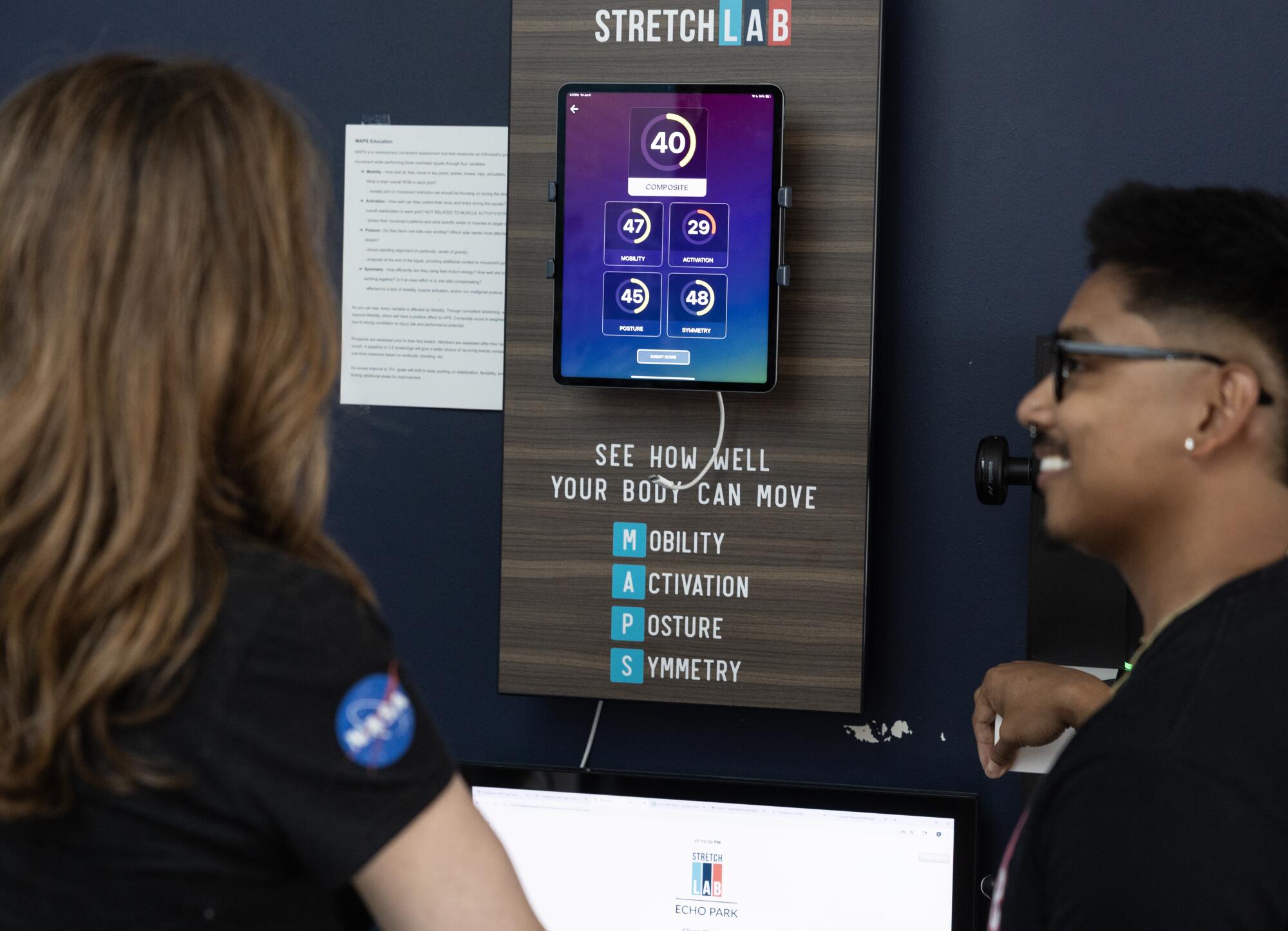
Flexologist Joel Badilla walks Deborah Vankin through the MAPS assessment process.
(Luke Johnson / Los Angeles Times)
My practitioner, Joel Badilla, walked me through the assessment before my 50-minute session (as a “drop in,” it cost me $125, but prices differ depending on the package and location). StretchLab uses a 3-D body scanning tool called MAPS, which TRX Training developed for them. It assesses mobility (range of motion), activation (quality of movement), posture and symmetry so as to isolate areas that are tight or imbalanced and customize a stretch program for the client. I did three overhead squats in front of an iPad before MAPS gave me a score in each area. (Scores far lower than I would have liked, the culprits being tight hips and “tech neck,” but such is the case with desk workers, I was told.)
Then I laid down on the table and Badilla lifted my legs and gently pulled them forward, toward him. It felt wonderful, as if my spine were elongating, all the stress draining from my back. He then put me through 26 stretches, 13 on each side of my body.

Joel Badilla tugs gently on Deborah Vankin’s legs at the start of her stretch session.
(Luke Johnson / Los Angeles Times)
StretchLab uses PNF stretching (proprioceptive neuromuscular facilitation), Badilla explained, which is a “push and release” technique. The recipient holds the stretch for a set period of time, then pushes into resistance provided by the practitioner for a shorter period of time, then goes back into a deeper version of the stretch. We did this repeatedly for different body parts.
Afterward, I felt loose and limber heading back to my car — though the sensation didn’t last for very long after my car ride home. That’s because the benefits of stretching come from consistency, says Amber Donaldson, vice president of Sports Medicine Clinics for the United States Olympic & Paralympic Committee.
“Just stretching once isn’t beneficial,” she says. “You need two weeks, minimum, of consistency to see a benefit. These [assisted stretching] places — paying for a series of treatments may keep you consistent with going.”
That said, there are questions around the benefits of stretching, overall, in the sports medicine community, Donaldson adds. “It’s controversial. When should you do it — before or after a workout — and to what extent is it beneficial at all? The jury is still out.”
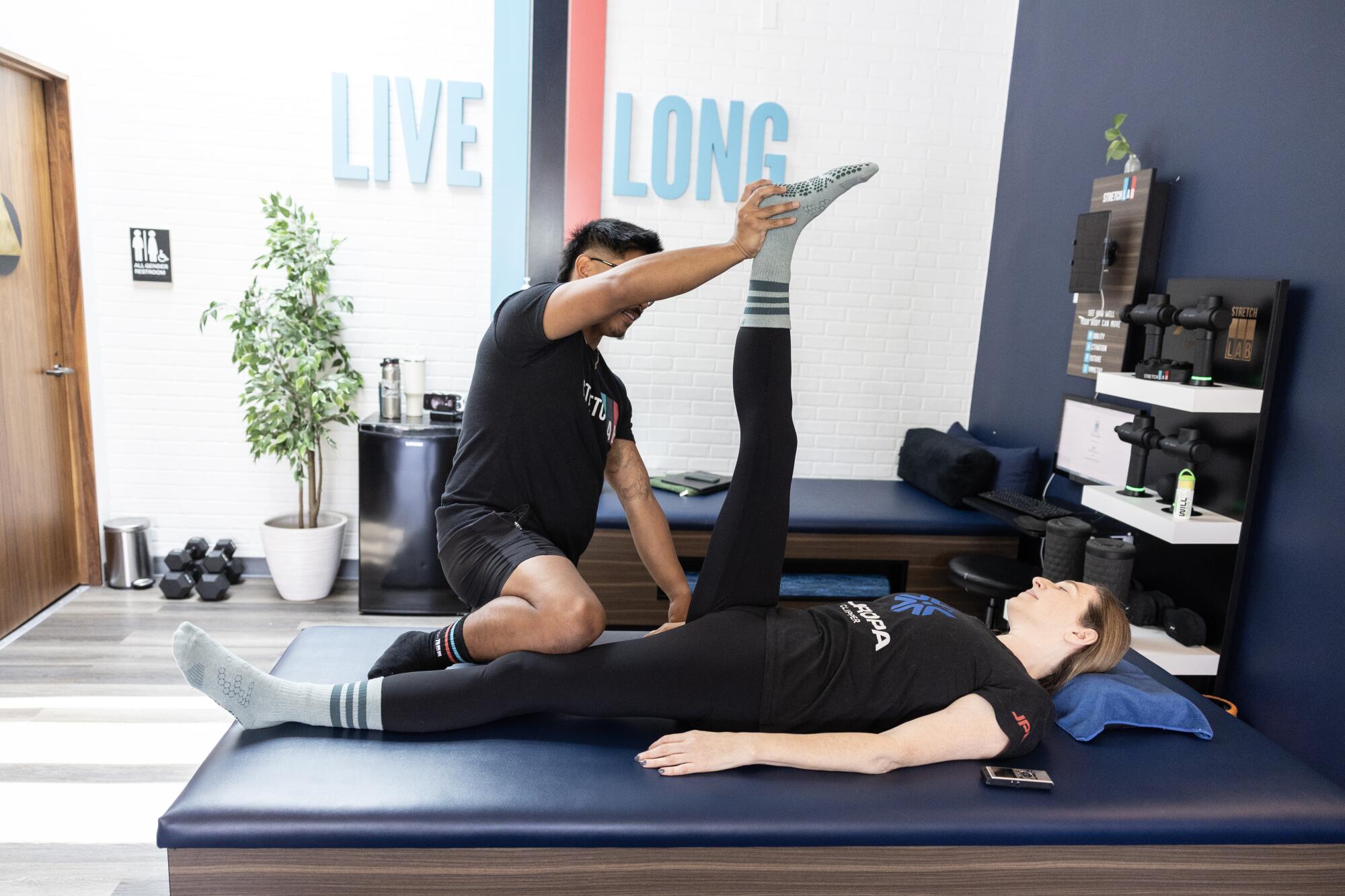
Assisted stretching, if done consistently over many weeks, may help with stiffness, pain relief and even injury prevention.
(Luke Johnson / Los Angeles Times)
StretchLab is far from an anomaly in L.A. There are more than half a dozen dedicated assisted stretching businesses in the area — and the trend, which began to swell nationwide in 2017-18, only seems to be growing. In addition to franchises like StretchLab and Stretch Zone, many personal trainers offer assisted stretching, as do most physical therapists. Gyms such as Life Time in Orange County and the Los Angeles Athletic Club offer one-on-one assisted stretching now. Even certain massage outlets, such as Massage Envy, offer 30 and 60-minute assisted stretching sessions.
The basic concept of assisted stretching is the same, no matter where you go, but different studios take slightly different approaches.
Stretch Zone in Redondo Beach and Rancho Palos Verdes doesn’t use the PNF technique. Instead, the studio (which has almost 400 outlets nationwide) uses a graduated stretch modality that moves the client along an intensity scale of one-10. It starts at a three “right when you first start to feel the stretch,” owner Deborah Ashley says, “and seven is where you want us to stop.” They also use a patented system of belts and straps on a stretch table “to secure and mobilize one side of your body while we stretch the other,” Ashley says. “It acts like a second set of hands for our practitioners.”
StretchMed in Glendale has only one location in the L.A. area (there are about 30 in the U.S.). It prides itself on not being part of an especially big franchise, says owner Carlos Rivera, adding that the studio takes a personal and data-driven approach to stretch therapy. It does use the PNF stretching technique but puts a good deal of emphasis on warming up before one-on-one stretch sessions. Toward that end, clients do 15-minute warm-up routines on so-called “stretch trainers,” which have tilted seats, leg pads and safety straps for stability. A video walks them through the routine, which includes gentle movement and is meant to stimulate circulation. “You want to warm up before you stretch,” Rivera says, “to get a much better benefit.”
Would I do assisted stretching again?
Absolutely — it was gentler than I imagined and I felt immediate relief afterward, particularly in my lower back.
Would I do it regularly?
Not for StretchLab’s membership rate of $320 a month, their cheapest monthly package of four 50-minute sessions (prices vary slightly by location). At Stretch Zone, the roughly comparable package of four 60-minute sessions is $400. At StretchMed, four 55-minute sessions is $216.
But on this particular Friday, at least, I headed into the weekend feeling looser and, if nothing else, an inch or so taller. I’ll take it.

Lifestyle
Doctors says ‘The Pitt’ reflects the gritty realities of medicine today

From left: Noah Wyle plays Dr. Michael “Robby” Robinavitch, the senior attending physician, and Fiona Dourif plays Dr. Cassie McKay, a third-year resident, in a fictional Pittsburgh emergency department in the HBO Max series The Pitt.
Warrick Page/HBO Max
hide caption
toggle caption
Warrick Page/HBO Max
The first five minutes of the new season of The Pitt instantly capture the state of medicine in the mid-2020s: a hectic emergency department waiting room; a sign warning that aggressive behavior will not be tolerated; a memorial plaque for victims of a mass shooting; and a patient with large Ziploc bags filled to the brink with various supplements and homeopathic remedies.
Scenes from the new installment feel almost too recognizable to many doctors.
The return of the critically acclaimed medical drama streaming on HBO Max offers viewers a surprisingly realistic view of how doctors practice medicine in an age of political division, institutional mistrust and the corporatization of health care.
Each season covers one day in the kinetic, understaffed emergency department of a fictional Pittsburgh hospital, with each episode spanning a single hour of a 15-hour shift. That means there’s no time for romantic plots or far-fetched storylines that typically dominate medical dramas.
Instead, the fast-paced show takes viewers into the real world of the ER, complete with a firehose of medical jargon and the day-to-day struggles of those on the frontlines of the American health care system. It’s a microcosm of medicine — and of a fragmented United States.

Many doctors and health professionals praised season one of the series, and ER docs even invited the show’s star Noah Wyle to their annual conference in September.
So what do doctors think of the new season? As a medical student myself, I appreciated the dig at the “July effect” — the long-held belief that the quality of care decreases in July when newbie doctors start residency — rebranded “first week in July syndrome” by one of the characters.
That insider wink sets the tone for a season that Dr. Alok Patel, a pediatrician at Stanford Medicine Children’s Health, says is on point. Patel, who co-hosts the show’s companion podcast, watched the first nine episodes of the new installment and spoke to NPR about his first impressions.
To me, as a medical student, the first few scenes of the new season are pretty striking, and they resemble what modern-day emergency medicine looks and sounds like. From your point of view, how accurate is it?
I’ll say off the bat, when it comes to capturing the full essence of practicing health care — the highs, the lows and the frustrations — The Pitt is by far the most medically accurate show that I think has ever been created. And I’m not the only one to share that opinion. I hear that a lot from my colleagues.
OK, but is every shift really that chaotic?
I mean, obviously, it’s television. And I know a lot of ER doctors who watch the show and are like, “Hey, it’s really good, but not every shift is that crazy.” I’m like, “Come on, relax. It’s TV. You’ve got to take a little bit of liberties.”
As in its last season, The Pitt sheds light on the real — sometimes boring — bureaucratic burdens doctors deal with that often get in the way of good medicine. How does that resonate with real doctors?
There are so many topics that affect patient care that are not glorified. And so The Pitt did this really artful job of inserting these topics with the right characters and the right relatable scenarios. I don’t want to give anything away, but there’s a pretty relatable issue in season two with medical bills.
Right. Insurance seems to take center stage at times this season — almost as a character itself — which seems apt for this moment when many Americans are facing a sharp rise in costs. But these mundane — yet heartbreaking — moments don’t usually make their way into medical dramas, right?
I guarantee when people see this, they’re going to nod their head because they know someone who has been affected by a huge hospital bill.
If you’re going to tell a story about an emergency department that is being led by these compassionate health care workers doing everything they can for patients, you’ve got to make sure you insert all of health care into it.
As the characters juggle multiple patients each hour, a familiar motif returns: medical providers grappling with some heavy burdens outside of work.
Yeah, the reality is that if you’re working a busy shift and you have things happening in your personal life, the line between personal life and professional life gets blurred and people have moments.
The Pitt highlights that and it shows that doctors are real people. Nurses are actual human beings. And sometimes things happen, and it spills out into the workplace. It’s time we take a step back and not only recognize it, but also appreciate what people are dealing with.
2025 was another tough year for doctors. Many had to continue to battle misinformation while simultaneously practicing medicine. How does medical misinformation fit into season two?
I wouldn’t say it’s just mistrust of medicine. I mean that theme definitely shows up in The Pitt, but people are also just confused. They don’t know where to get their information from. They don’t know who to trust. They don’t know what the right decision is.
There’s one specific scene in season two that, again, no spoilers here, but involves somebody getting their information from social media. And that again is a very real theme.
In recent years, physical and verbal abuse of healthcare workers has risen, fueling mental health struggles among providers. The Pitt was praised for diving into this reality. Does it return this season?
The new season of The Pitt still has some of that tension between patients and health care professionals — and sometimes it’s completely projected or misdirected. People are frustrated, they get pissed off when they can’t see a doctor in time and they may act out.
The characters who get physically attacked in The Pitt just brush it off. That whole concept of having to suppress this aggression and then the frustration that there’s not enough protection for health care workers, that’s a very real issue.
A new attending physician, Dr. Baran Al-Hashimi, joins the cast this season. Sepideh Moafi plays her, and she works closely with the veteran attending physician, Dr. Michael “Robby” Robinavitch, played by Noah Wyle. What are your — and Robby’s — first impressions of her?
Right off the bat in the first episode, people get to meet this brilliant firecracker. Dr. Al-Hashimi, versus Dr. Robby, almost represents two generations of attending physicians. They’re almost on two sides of this coin, and there’s a little bit of clashing.

Sepideh Moafi, fourth from left, as Dr. Baran Al-Hashimi, the new attending physician, huddles with her team around a patient in a fictional Pittsburgh teaching hospital in the HBO Max series The Pitt.
Warrick Page/HBO Max
hide caption
toggle caption
Warrick Page/HBO Max
Part of that clash is her clear-eyed take on artificial intelligence and its role in medicine. And she thinks AI can help doctors document what’s happening with patients — also called charting — right?
Yep, Dr. Al-Hashimi is an advocate for AI tools in the ER because, I swear to God, they make health care workers’ lives more efficient. They make things such as charting faster, which is a theme that shows up in season two.
But then Dr. Robby gives a very interesting rebuttal to the widespread use of AI. The worry is that if we put AI tools everywhere, then all of a sudden, the financial arm of health care would say, “Cool, now you can double how many patients you see. We will not give you any more resources, but with these AI tools, you can generate more money for the system.”
The new installment also continues to touch on the growing corporatization of medicine. In season one we saw how Dr. Robby and his staff were being pushed to see more patients.
Yes, it really helps the audience understand the kind of stressors that people are dealing with while they’re just trying to take care of patients.
In the first season, when Dr. Robby kind of had that back and forth with the hospital administrator, doctors were immediately won over because that is such a big point of frustration — such a massive barrier.
There are so many more themes explored this season. What else should viewers look forward to?
I’m really excited for viewers to dive into the character development. It’s so reflective of how it really goes in residency. So much happens between your first year and second year of residency — not only in terms of your medical skill, but also in terms of your development as a person.
I think what’s also really fascinating is that The Pitt has life lessons buried in every episode. Sometimes you catch it immediately, sometimes it’s at the end, sometimes you catch it when you watch it again.
But it represents so much of humanity because humanity doesn’t get put on hold when you get sick — you just go to the hospital with your full self. And so every episode — every patient scenario — there is a lesson to learn.
Michal Ruprecht is a Stanford Global Health Media Fellow and a fourth-year medical student.
Lifestyle
In Beauty, Private Equity Is Hot Again

Lifestyle
10 books we’re looking forward to in early 2026

Two fiction books about good friends coming from different circumstances. Two biographies of people whose influence on American culture is, arguably, still underrated. One Liza Minnelli memoir. These are just a handful of books coming out in the first few months of 2026 that we’ve got our eye on.
Fiction

Autobiography of Cotton, by Cristina Rivera Garza, Feb. 3
Garza, who won a Pulitzer in 2024 for memoir/autobiography, actually first published Autobiography of Cotton back in 2020, but it’s only now getting an English translation. The book blends fiction with the author’s own familial history to tell the story of cotton cultivation along the U.S.-Mexico border.

Crux, by Gabriel Tallent, Jan. 20
Tallent’s last novel, My Absolute Darling, was a harrowing coming of age story about a teenage girl surviving her abusive survivalist father. But it did find pockets of beauty in the outdoors. Tallent’s follow up looks to be similarly awestruck by nature. It’s about two young friends, separated by class and opportunity, but bound together by a love of rock climbing.

Half His Age, by Jennette McCurdy, Jan. 20
The former iCarly actress’ bracing and brutally honest memoir, I’m Glad My Mom Died, was a huge hit. It spent weeks on bestseller’s lists, and is being adapted into a series for Apple TV+. Now McCurdy’s set to come out with her fiction debut, about a teenage girl who falls for her high school creative writing teacher.

Kin, by Tayari Jones, Feb. 24
Similarly to Crux, Kin also follows two friends across the years as options and opportunities pull them apart. The friends at the center of this book are two women who grew up without moms. Jones’ last novel, 2018’s An American Marriage, was a huge hit with critics.

Seasons of Glass & Iron: Stories, by Amal El-Mohtar, March 24
El-Mohtar is an acclaimed science-fiction writer, and this book is a collection of previously published short stories and poetry. Many of the works here have been honored by the big science-fiction/fantasy awards, including the titular story, which is a feminist re-telling of two fairy tales.
Nonfiction

A Hymn to Life: Shame Has to Change Sides, by Gisèle Pelicot, Feb. 17
Pelicot’s story of rape and sexual assault – and her decision to wave anonymity in the trial – turned her into a galvanizing figure for women across the world. Her writing her own story of everything that happened is also a call to action for others to do the same.

Cosmic Music: The Life, Art, and Transcendence of Alice Coltrane, by Andy Beta, March 3
For decades, the life and work of Alice Coltrane has lived in the shadow of her husband, John Coltrane. This deeply researched biography hopes to properly contextualize her as one of the most visionary and influential musicians of her time.

Football, by Chuck Klosterman, Jan. 20
One of our great essaysists and (over?) thinkers turns his sights onto one of the last bits of monoculture we’ve got. But in one of the pieces in this collection, Klosterman wonders, how long until football is no longer the summation of American culture? But until that time comes, there’s plenty to dig into from gambling to debates over the true goat.

Kids, Wait Till You Hear This! by Liza Minnelli, with Michael Feinstein, March 20
Minnelli told People that previous attempts at telling her story “didn’t get it right,” so she’s doing it herself. This new memoir promises to get into her childhood, her marriages, and her struggles with substance abuse.

Tom Paine’s War: The Words that Rallied a Nation and the Founder of Our Time, by Jack Kelly, Jan. 6
If you haven’t heard, it’s a big birthday year for America. And it’s a birthday that might not have happened if not for the words of Thomas Paine. This new book from historian Jack Kelly makes the argument that Paine’s words are just as important and relevant to us today.
-

 Detroit, MI6 days ago
Detroit, MI6 days ago2 hospitalized after shooting on Lodge Freeway in Detroit
-

 Technology3 days ago
Technology3 days agoPower bank feature creep is out of control
-

 Dallas, TX4 days ago
Dallas, TX4 days agoDefensive coordinator candidates who could improve Cowboys’ brutal secondary in 2026
-

 Health5 days ago
Health5 days agoViral New Year reset routine is helping people adopt healthier habits
-

 Nebraska2 days ago
Nebraska2 days agoOregon State LB transfer Dexter Foster commits to Nebraska
-

 Iowa3 days ago
Iowa3 days agoPat McAfee praises Audi Crooks, plays hype song for Iowa State star
-

 Nebraska3 days ago
Nebraska3 days agoNebraska-based pizza chain Godfather’s Pizza is set to open a new location in Queen Creek
-

 Entertainment2 days ago
Entertainment2 days agoSpotify digs in on podcasts with new Hollywood studios







